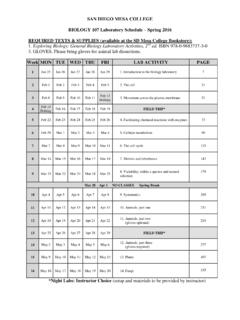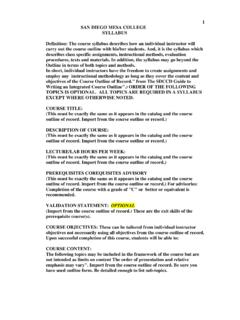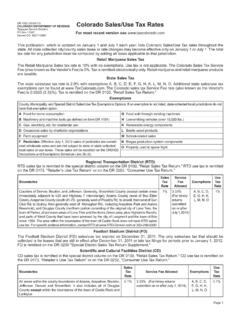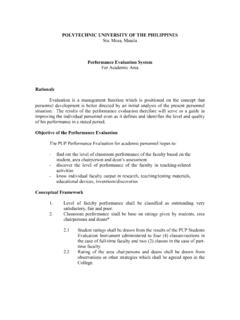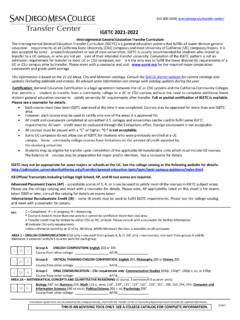Transcription of Find p-values with the Ti83/Ti84 - San Diego Mesa College
1 p-values with the Ti83/Ti84 Note: The majority of the commands used in this handout can be found under the DISTR menu which you can access by pressing [2nd] [VARS]. You should see the following: NOTE: The calculator does not have a key for infinity ( ). In some cases when finding a p-value we need to use infinity as a lower or upper bound. Because the calculator does not have such a key we must use a number that acts as infinity. Usually it will be a number that would be off the chart if we were to use one of the tables.
2 Please note this in the following examples. Z-table p-values : use choice 2: normalcdf( 1. NOTE: Recall for the standard normal table (the z-table) the z-scores on the table are between and In essence for this table a z-score of 10 is off the charts, we could use 10 to act like infinity. a. Left-tailed test (H1: < some number). The p-value would be the area to the left of the test statistic. Let our test statistics be z = The p-value would be P(z < ) or the area under the standard normal curve to the left of z = Notice that the p-value is.)
3 0222. We can find this value using the Normalcdf feature of the calculator found by pressing [2nd] [VARS] as noted above. The calculator will expect the following: Normalcdf(lowerbound, upperbound). Try typing in: Normalcdf(-10, ) , after pressing [ENTER] you should get the same p-value as above. It will look like the following on the calculator: Notice the p-value matches the one under the normal curve given earlier. It also matches the p-value you would get if you used the standard normal table. Note: For the p-value in our example we need the area from z = - to z = The calculator does not have a key for - , so we need to chose a value that will act like.
4 If we type in Normalcdf(-10, ) the 10 is acting as - . b. Right tailed test (H1: > some number): The p-value would be the area to the right of the test statistic. Let our test statistics be z = The p-value would be P(z > ) or the area under the standard normal curve to the right of z = The p-value would the area to the right of on the z-table. Notice that the p-value is .0322, or P(z > ) = .0322. We could find this value directly using Normalcdf( ,10). Again, the 10 is being used to act like infinity.
5 We could use a larger value, anything that is large enough to be off the standard normal curve would suffice. On the calculator this would look like the following: Notice that the p-value is the same as would be found using the standard normal table. c. Two tailed test (H1: some number): Do the same as with a right tailed or left-tailed test but multiply your answer by 2. Just recall that for a two-tailed test that: The p-value is the area to the left of the test statistic if the test statistics is on the left.
6 The p-value is the area to the right of the test statistic if the test statistic is on the right. T-table p-values : use choice 6: tcdf( 2. The p-values for the t-table are found in a similar manner as with the z-table, except we must include the degrees of freedom. The calculator will expect tcdf(loweround, upperbound, df). a. Left-tailed test (H1: < some number) Let our test statistics be and n =16, so df = 15. The p-value would be the area to the left of or P(t < ) Notice the p-value is .0291, we would type in tcdf(-10, ,15) to get the same p-value.)
7 It should look like the following: Note: We are again using 10 to act like - . Also, finding p-values using the t-distribution table is limited, you will be able to get a much more accurate answer using the calculator. b. Right tailed test (H1: > some number): Let our test statistic be t = and n = 36, so df = 35. The value would be the area to the right of t = Notice the p-value is .0296. We can find this directly by typing in tcdf( , 10, 35) On the calculator this should look like the following: c.
8 Two tailed test (H1: some number): Do the same as with a right tailed or left-tailed test but multiply your answer by 2. Just recall that for a two-tailed test that: The p-value is the area to the left of the test statistic if the test statistics is on the left . The p-value is the area to the right of the test statistic if the test statistic is on the right. Chi-Square table p-values : use choice 8: 2(cdf 3. The p-values for the 2-table are found in a similar manner as with the t-table. The calculator will expect loweround, upperbound, df).
9 2(cdf a. Left-tailed test (H1: < some number) Let our test statistic be with n = 27 so df = 26. =The p-value would be the area to the left of the test statistic or to the left of . To find this with the calculator type in , on the calculator this should look like the following: =2(0, , 26)cdf So the p-value is .00118475, or 2( ).0011P <= Note: recall that 2 values are always positive, so using 10 as a lower bound does not make sense, the smallest possible 2 value is 0, so we use 0 as a lower bound.)
10 B. Right tailed test (H1: > some number) Let our test statistic be with n = 61 and df = 60. =The p-value would be the are to the right of the test statistic or the right of . To find this with the calculator type in , on the calculator this should look like the following: =2( , 200, 60)cdf So the p-value is .0176 or 2( ).0176P <=Note: 2 values can be much larger than z or t values, so our upper bound in this example was 200. You can always look at the 2 to get an idea of how large to pick your upper bound.
